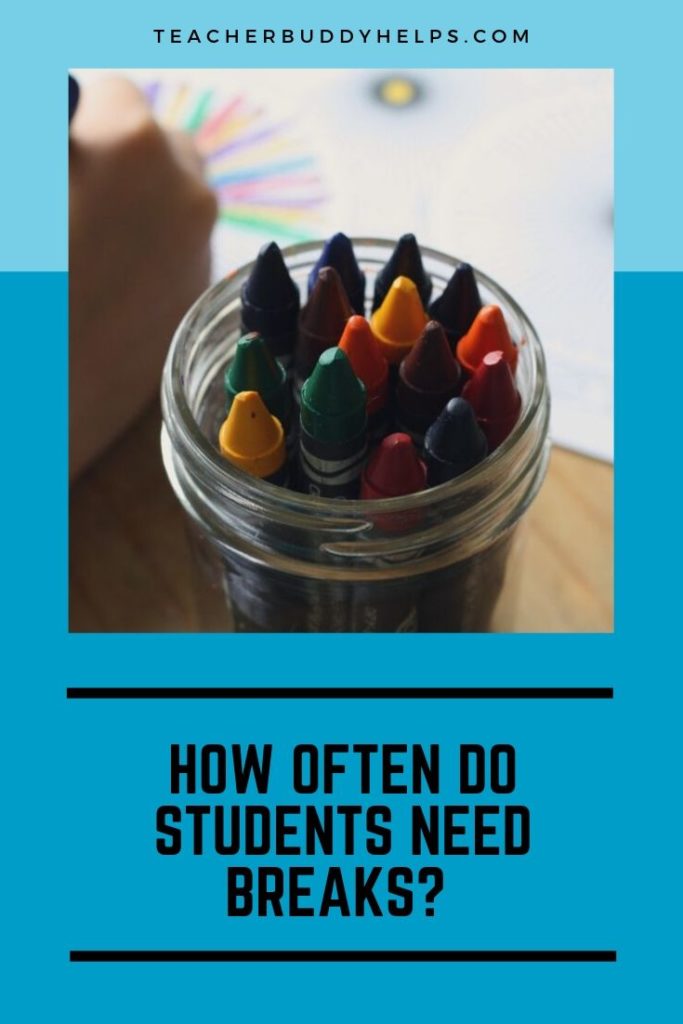Do students need breaks to increase focus on content?

I know, you are thinking; my recess breaks are already scheduled in the day; I don’t have any decision making power regarding when they can take breaks.

And why do students need breaks anyway?
Well, the gist (don’t you just love that word) of this point is to remind us all that the younger the students, the less time they can spend sitting still.
Hey, those of you with the new-fangled “alternative seating” are super lucky! I wish they had that when I was teaching. Those little kiddos can squirm and wiggle while they work. How Fun!!
I digress…..
Kinder students have an attention span of about 20 minutes* (on a good day).
So, what does that mean, you’re wondering? “Is she implying they need a break each 20 minutes?”
NO, THAT’S NOT WHAT I MEAN!

Change Activities Often in Primary Grades.
What I mean, is that your lessons need to change activities that often.
If you are teaching the sound for the letter “b” transition from a sitting activity to a standing up one, then back to sitting. This doesn’t need to be more than a few seconds. If you’re a Kindergarten teacher, you probably already have a handful of chants and rhymes to get kids sitting quietly again.
And if you don’t, ask your neighbor teacher, or look it up on Pinterest. You need to use rhymes and chants in Kindergarten.
For First grade students, the attention span is about 30 minutes.* With the new high stakes Common Core standards (or other state standards), the Language Arts period has increased in many primary grades to 2 1/2 to 3 hours.
Do they always need to move from sitting down to standing up? NO, THAT’S NOT WHAT I MEAN EITHER!
Incorporate Movement Breaks in the Classroom (especially in the Primary Grades).
Well, a young 6, 7, or 8-year-old student cannot sit still and concentrate for that long without some type of break or
Perhaps they can move from their desk to the carpet area, (or vice versa). Allow them to write ideas on chart paper around the classroom. Even a quick break where they stand up and reach for the sky, then touch their toes before sitting down again will work wonders for their attention span.
Interject times of partner sharing, or group talk, then regain attention to move on.
The point being is that you shouldn’t be lecturing, like the “sage on the stage” for an hour or more on each topic in the day.
Speaking of switching up your lessons, you will need to be sure that you have strong, consistent classroom routines in place that you have taught the students at the beginning of the year (and practiced over and over). If you’d like to see the classroom routines I set up for my classes, I am sharing it with my readers for FREE.
Complete the form below and once I have your email address, I will zip it right over to you.
**
Provide guided practice, have them chorally respond to questions, teach them hand-motions for concepts. There are quite a few “active engagement strategies” out there for you to use.
Here is an article I wrote about other highly effective instructional practices. You can access it here:
So, I guess you’ve figured out that you can increase the “listening to lecture” time a bit more with each grade. My best estimate would be 5 minutes more per grade level, so by seventh grade, students can probably concentrate for about an hour.*
Active Engagement in College Too
Even College students need to be actively engaged and not sit for 50 minute lectures all the time. Many colleges are beginning to ask faculty to incorporate more Active Learning into their course.
Students need to be engaged no matter what their age.
NOW, I want to also explain the importance of repetition to learning. Students need to hear and repeat information numerous times in order to retain the information in their memories.
New concepts for each lesson need to be repeated at least seven (7) times during instruction; they can be telling their partner or hearing it from other students.
Research has shown that if information is repeated or recalled for 10 minutes on the next day after the first “learning” and then again for 5 minutes seven days later and then 2-4 minutes 30 days after the lesson, that students will retain the information.
Researchers studying this call it the “Curve of Forgetting.”
Wouldn’t it be easy to have students partner share the information after you’ve reviewed it the next day (only spending about 10 minutes for both)? Then on day 7, a two-minute explanation and then ask them to write a quick summary for 3 minutes.
Lastly, a month later, mention it for 2-4 minutes and allow a few student to recall the lesson. Be sure to maintain classroom control during these bits of “recall.”
Here is another article that I wrote about the correct way to conduct partner sharing. You can access it here.
How to Use Effective Partner Sharing as an Instructional Strategy
So, remember to add breaks into the class periods and lectures…remember, you never liked long lectures in college either. And repeat new information throughout each lesson; over and over. Because these breaks are crucial for brain development and optimal learning.
Let Me Know How the Breaks Are Working for You.
Your Teacher Buddy
*this is not scientific data, or anything from an expert, just my experience from years in first grade and experience in other grades as well.






